|
FAQs about Marine Crab Identification
10
Related Articles: Crabs,
Hermit
Crabs,
Related FAQs: SW Crab Identification 1,
SW Crab ID 2, SW Crab ID 3, SW Crab ID 4, SW Crab ID 6, Marine Crab ID 7, Marine Crab ID 8, Marine Crab ID 9, Marine Crab ID 11, Marine Crab ID 12, SW Crab ID 13, SW Crab ID 15, SW Crab ID 16, SW Crab ID 17, SW Crab ID 18,
SW Crab ID 19,
SW Crab ID 20,
SW Crab ID 21,
SW Crab ID
22,
& Marine Invertebrate
identification, Marine
Crabs 1, Marine
Crabs 2, Marine
Crabs 3, Marine Crabs
4, & Crab
Behavior, Marine Crab
Selection, Marine Crab
Compatibility, Marine Crab
Systems, Marine Crab
Feeding, Marine Crab
Reproduction, Marine Crab
Disease, Micro-Crustaceans, Amphipods, Copepods, Mysids, Hermit
Crabs, Shrimps,
Cleaner
Shrimps, Banded
Coral Shrimp,
Mantis Shrimp,
Anemone Eating Shrimp, Crustacean Identification,
Crustacean Selection,
Crustacean Behavior,
Crustacean
Compatibility, Crustacean Systems, Crustacean Feeding, Crustacean Disease, Crustacean
Reproduction,
|
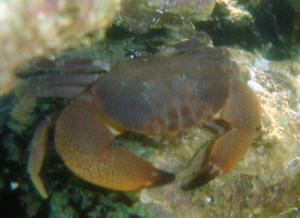
|
| Re: Another questions :) ATTN Mitch... crab ID,
WWM Crewmember gender/name mis-ID 6/10/08 Hi
Mitch, <Hi Patrick,> While I was pursuing the Aiptasia
tonight (got a good start) <Congrats.> I noticed a little
green crab in my turtle grass, then I noticed there are 2...
<perhaps a breeding pair.> I don't know how I missed
these guys. <Easily done.> They aren't emeralds, <No
they are not.> Looked all over WWM can't find any that look
like these, although I did see a post about a crab a guy found in
his turtle grass and you guys weren't sure what it was...
<Sorry, I'm not too much help here. It is a very distinctive
crab, and I thought I might be able to find more information for
you. From the images it does appear to be a very pretty shade of
green, which I thought would be most helpful in the identification.
I also thought the turtle grass might be a clue as well but I
didn't have any luck searching along that route either. I'm
at a loss. Your crabs appear a little more refined and sort of
remind me of some commensal crabs found in association with some
corals, but most crabs are opportunistic omnivores and are not to
be trusted. You might want to isolate these guys in a sump so they
don't cause trouble. More info here:
http://www.wetwebmedia.com/marine/inverts/arthropoda/crabs/swcrabs.htm
and related links in blue and here:
http://www.chucksaddiction.com/hitchcrabs.html Michelle> |
|
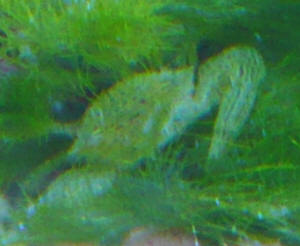
Re: Another questions :) ATTN Mitch... crab
ID 6/23/08 Thanks Michelle,
<Welcome Patrick, sorry for the long delay. I was hoping to
come up with an ID for you, but didn't make much progress,
sorry.> I was leaning towards some sort of porcelain crab but
after watching them for a while last night I was able to see that
they have 4 legs on each side in addition to their claws so they
are true crabs. Also I noticed that the very tips of the claw has
white on them. If you guys don't know what they are they must
be very uncommon. <No, not necessarily, but not something I am
familiar with.> Not sure what to do with them, they never seem
to leave their turtle grass home and as I was watching them last
night, they seem to be filter feeding, <It is possible.>
they climb up the grass, push it apart and you can see their
mouth parts going a mile a minute. <I would likely allow them
to stay in place.> I had one of the turtle grasses in the sump
for a while, it didn't like it there, probably because of the
crappy light 4700K compact fluor bulb I have down there... It
turned yellow, <Mmm, sounds like it wasn't getting enough
nutrients, may have been more a sandbed issue than a lighting
issue, Thalassia prefers a deep, enriched, substrate, 3-4 inches
minimum, for optimum growth and development, thought the grass
would prefer closer to daylight lighting, i.e. 10,000K.> I moved
it to the main tank and it started growing like crazy! <Better
conditions for it. Good luck with these little guys. I would just
keep an eye on them. Cheers, Mich>
|
|
Please could you ID this crab: Likely Xanthid -
6/7/08 Hi, <Hi Ranjith, Lynn here today.> I found this
fellow in my 5 month old tank. <Okay> Couple of
observations in the tank (might be or not because of him). 1.
Found empty shells of similar but small crab (maybe this one
moulted?) <Either that, or there are multiple crabs
present.> I observed this over last 2-3 months. From the last
2 weeks he is active and is seen around the tank. 2. Found a
piece of my moon coral torn off. <Ouch!> I saw him trying
to burrow under the moon coral once a week or so ago but he left
the place in some time. He does not go there as far as I have
observed but maybe when it's dark?? Yesterday night I found a
small 2cm piece of the moon coral not far from the coral itself.
<Mmmm, not good.> Other inhabitants are: 1. Flame angel 2.
Bicolor blenny 3. Skunk clowns Tank is 120 gal bowfront Would you
need more info to ID this crab? <Unfortunately, there are so
many possibilities that without having the crab directly in front
of me and knowing where it's from, the best I can do is ID it
to one of two families. The first is Cancridae. These are also
called 'Rock crabs' and often have fluted, toothed, or
scalloped carapace edges. I can't quite tell in the
photograph if your crab has this feature or not. It actually
looks rather smooth to me, so if that's the case then
it's more than likely something in the family Xanthidae.
Xanthids, ('Mud' crabs) are common hitchhikers and are
unfortunately some of the more notorious crabs as far as their
potential for being destructive. Some are coral commensals, and
relatively innocuous, but all are omnivorous with the potential
to cause problems. That goes for crabs in the family Cancridae as
well. I would recommend either trapping and relocating this crab,
or keeping it well fed in hopes of discouraging it from sampling
your desirable livestock. If it were me, I'd relocate it. For
more information, please see the following links:
http://www.wetwebmedia.com/marine/inverts/arthropoda/crabs/swcrabs.htm
http://www.chucksaddiction.com/hitchcrabs.html
http://en.wikipedia.org/wiki/Cancridae Cheers and Thanks Again
<You're very welcome! Take care, -Lynn>
|
|

|
| Small crab in brain coral
5/13/08 First off, let me say this is the greatest site
I've ever stumbled upon and you've answered many of my
questions about my reef tank. Now, here's my situation: I
bought a colored brain coral this weekend. The coral has been
inflating and deflating throughout the day, and it has eaten but
today I noticed a spot that I thought was tissue recession. After
observing it all day, I saw that it is a tiny (I mean really tiny)
crab living inside it. It has eaten a tunnel out of the coral.
<It is a coral-gall crab or gall crab... very interesting
creatures.> I tried to remove it with tweezers and I thought I
killed it, but it just backs up into the coral and I can't get
it. I don't want to lose this coral, but I really don't
want the crab to migrate to my pride and joy bubble coral, or any
of my other LPS. Do you think this crab will eat the coral its in?
<No worries, they are harmless and don't appear to reproduce
in captivity (or, if they do, not enough that anyone has ever
reported a problem with them). I myself have had both a male and a
female in my tank. The female even had eggs at one point. But I
never noticed any babies (nor any new crabs).> Is there any way
I can flush it out? I really want it gone. <Aww, please consider
letting the little guy live. They're not harmful and are
actually quite interesting little creatures. Some people say they
never leave their holes, but I have this picture I think
"proves" otherwise. Please pay no mind to the state of
the coral they're on... that was not at all their fault, I had
accidently dropped the coral in a bucket of vinegar (actually, come
to think of it maybe that's why the crab came out of the hole).
lol That's NOT a suggestion!! ...certainly did more harm the
coral than to the crab! ::sigh:: Sara M.> |
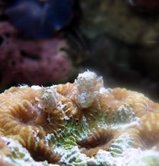 |
Black Crab ID: Start With WWM Sources - 4/21/08
<Hello> Need help ID'ing a stowaway on a Tonga live rock. I
haven't gotten a clear shot of it, he's pretty shy. It's a
dime sized crab, all black, with a pattern of white lines on its back.
It has not left the rock it lives in, and when I do see him, he quickly
hides. <Typical> I'll send a pic as soon as I catch him.
<Sounds good. Best case scenario would include detailed photos from
above, beneath, and face-on. Even then, identifying crabs to the
species level can be very difficult indeed. However, with enough
information we should be able to narrow it to a basic group. In the
meantime, please read through the information and compare the photos at
WWM regarding crabs. Start at this link, and be sure to go through the
associated links at the top as well:
http://www.wetwebmedia.com/marine/inverts/arthropoda/crabs/swcrabs.htm
Take care, -Lynn>
|
Tiny White Crab on Montipora capricornis: Gall crab -
4/8/08 Hey all. <Hi Andy> I have a Montipora
capricornis on which I found a tiny white crab (I think). When I
noticed it this morning, I thought it was simply a piece of
debris hanging off the coral, but tonight with the lights out and
a focused flashlight I was able to see that it was in fact some
type of animal. I was able to suck it off with a turkey baster.
It is very tiny, so without a magnifying glass I can't make
out its features very well, but it does have at least 4 legs on
each side. <Thanks, that's an important bit to know when
identifying crabs!> The best way I can describe it is to tell
you it looks like a white deer tick. <Oh man, do I ever
despise ticks! They're creepy little bloodsuckers!> I have
attached pictures--I hope you can make it out. <Unfortunately,
I can't see enough to differentiate between the two crab
families I have in mind. However, I'm hoping that the photo
links I'll list below will help you determine which one it
really is.> I searched around on WWM to see if anything popped
up on this subject that might give me an ID, but I came up empty
handed. I note that the flesh of the coral at which this crab was
attached all day is totally undamaged, so I'm thinking (and
hoping) that it is not a threat <Not likely, no. Most are
small commensals.> (although I disposed of the crab anyway).
However, there is a tiny, round hole in the structure of the
coral that is under the place this crab was attached and that
looks like it has been there a while (see pic--maybe the crab was
living in this hole?). <Very likely, yes.> Any thoughts on
what this crab might be? <It looks like something either in
the family Cryptochiridae (coral pit/gall crabs -- many genera)
or the family Xanthidae (genus Cymo - gall crabs). I've never
heard of these crabs inhabiting Montipora corals before, but
considering how little I really know and how much I still need to
learn about them, that doesn't mean a whole lot! One thing
that's going to help that I can't see in the photos
relates to the claws. If those on your crab were easily seen and
fairly robust, possibly dark tipped, then it's likely a Cymo
sp (Xanthid). If, however, your crab had barely noticeable,
slender claws, then it's likely a Cryptochirid. The crabs in
this last family look more like ticks to me, but take a look and
see what you think (the first two are Cryptochirids):
Hapalocarcinus:
http://cookislands.bishopmuseum.org/species.asp?id=7372
Cryptochirus:
http://cookislands.bishopmuseum.org/species.asp?id=7200 Cymo:
http://decapoda.free.fr/illustration.php?n=3&sp=212 > As
always, thanks for your help/time. Andy <You're most
welcome. Take care, -Lynn>
Re: Tiny White Crab on Montipora capricornis:
Gall crab - 4/8/08 Lynn, <Hi Andy> Thank you for the
response. <You're most welcome.> Hmmm, hard to tell.
The claws definitely were NOT noticeable. In fact, I couldn't
see them at all--the only things I could see were the 4 legs on
each side. It resembles the Cryptochirid, but doesn't look
like an exact match. <It may be something else within the
Cryptochiridae family. Unfortunately, those were the only two
online examples I could find of the different genera within that
family. Depending on where you look, there are anywhere between 6
to 20 different genera and beyond that, a whole slew of species
so there are lots of possibilities.> I'm just glad it
likely was not harmful to the coral. <Me too!> The marine
world is a strange and fascinating one. <It is indeed! Take
care, -Lynn>
|
|
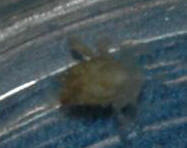 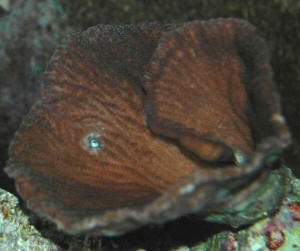
|
|
Sea Apple Hitchhiker: Pea Crab - 3/21/08 Hi,
<Hi there Joe> I am researching this for someone and I
haven't been able to get an answer as of yet, I was hoping
someone here could help me. <Hope so!> This particular
issue is with a Sea Apple <Uh-oh> it showed signs of not
doing so well for a few days. There was a white portion of it
looking like it was deteriorating and expelling its insides.
<Not good> Since then and further observation the owner
noticed that there was something inside the sea apple, it was a
small crab or what looks like a crab. <Yep> Do you know or
have heard of this happening, <Not specifically with Sea
Apples/Pseudocolochirus spp., but I've heard of it in
relation to other Cukes/Holothuroids. Sea cucumbers can be hosts
to many different organisms, including Pearlfishes/Carapidae,
Polynoid Polychaete worms, Periclimenes shrimps, as well as crabs
(Pinnotherids, Portunids/Lissocarcinus orbicularis,
Eumedonids/Hapalonotus reticulatus, etc.).> and what type of
crab this is. <Looks to be a Pea Crab, family Pinnotheridae.
These are small crabs that live in Cukes, tunicates, bivalves,
etc., with varying degrees of commensalism to downright
parasitism. While some live and do only low key, if any damage to
its host, others can cause more threatening damage, such as
atrophy of the respiratory organs/'trees'. Here are some
examples of this family of crabs:
http://www.unige.ch/sciences/biologie/biani/msg/teaching/photos%20liste/Pinnotheres%20pisum.JPG
http://outdoors.webshots.com/photo/2762668420086890761xKfyFR >
I attached a pic for reference, <Thanks, good photo!> up
until the white deterioration of the portion of the apple it was
healthy and doing well. Tank is a 150gal, 0 nitrates, salinity
1.024 and pH 8.4. <I'm guessing that the crab has been
removed permanently from the Sea Apple. If not, I would do so. I
would also recommend keeping a close eye on the Sea Apple for
further decline. They can do significant damage to a system when
they die! Please see this link for more information re:
http://www.wetwebmedia.com/seacukes.htm > Joe Brillon <Take
care, -Lynn>
Re: Sea Apple Hitchhiker: Pea Crab -- Now, Sea
Apple in Trouble - 3/24/08 <Hi Joe> Thank you very much
for your response as I have passed the info on. <You're
very welcome.> It appears now that the area of concern has
worsened. <I'm so sorry.> And the cause is
unknown...any idea's what could of caused deterioration in
the body of this animal? <No, I'm sorry to say that I
don't. There are many possible causes including
predation/picking/rough handling at some point. It could have
gotten too close to a heater, pump intake etc, or it could be
starving and deteriorating. These are notoriously difficult
animals to keep. They need pristine/stable water conditions, a
good supply of food, and lack of predation to survive - and in
this case, to have a shot at recovery. Also, unless the Sea Apple
is in a species tank/kept alone, I would move it to a quarantine
tank to avoid the possibility of its poisoning the other
tank's inhabitants. At the very least, I'd run
carbon/PolyFilter, and have a large amount of prepared water on
hand for a major water change should the Cuke decline
further/die. Signs of decline would include deflation, expelling
of insides, and losing color. Either way, I'd have a QT set
up for either the Cuke to go into immediately, or the
fish/shrimps, etc, to be moved into should the worst happen.
Please see this link for more information regarding Sea
Apples/tank poisonings.
http://www.wetwebmedia.com/cukeselfaqs.htm > Joe Brillon
<Sure hope everything works out for your friend and the Sea
Apple. Take care, -Lynn>
|
|
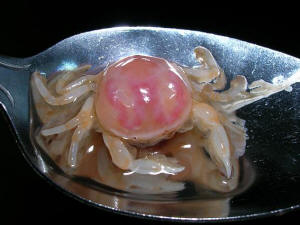 Crab soup du jour? Crab soup du jour?
|
| LR Hitchhiking Crab ID Please: Xanthid and
Possible Lissocarcinus sp. -- 3/20/08 Hi Crew, <Hi there
Tracy!> I'm hoping you can help me id these two little guys
that have been living in my Fiji live rock. They're crabs, but
definitely not the ones I bought! Both very shy but have made a few
appearances. They've doubled in size since we noticed them in
our setup (now almost an inch across). They don't seem to
bother any of our hermits or snails, however, 3 hermit crabs have
gone missing, one of our newest has lost an arm, and our Skunk
Cleaner Shrimp has just finished growing one of his arms back (we
initially thought due to one very territorial yellowtail blue
damsel). <Feisty little fellas!> Could these guys be the
culprits instead? <If the two crabs are about an inch across the
carapace (not including the legs), then yep, it's entirely
possible. It could instead, though, be another larger hermit, crab,
or even another shrimp depending on what species. There are lots of
possibilities.> I've managed to narrow the first one down:
<Good for you, I'm truly impressed! I know how time
consuming and challenging this process can be!> ..it
wouldn't be Hoplophrys oatesii b/c they're too spiny; it
wouldn't be Mithrax cinctimanus b/c they're too fuzzy
looking; could it be a variant of Lissocarcinus laevis or
Lissocarcinus orbicularis??? The last seems most likely to me.
<Yep, it could be that or something else in the same genus.
Check the last/rear pair of walking legs for paddle-like structures
on the tips. Lissocarcinus is in a family of swimming crabs,
Portunidae, so the presence/absence of these should help
confirm/exclude.> The second photo shows only the exoskeleton of
the white-armed crab (his eyes are missing). I haven't been
able to figure him out at all. <Looks like one of many possible
Xanthid species (sorry I can't be more specific). Some are
commensals, others just hang out in the rockwork/substrate. All are
opportunistic scavengers (same goes for Lissocarcinus). As neat
looking as both of these crabs are, they unfortunately have the
potential to become destructive, particularly as they grow larger.
You could try to deter predation by keeping them well fed, or
instead place them in a sump or the like where they can't get
into any trouble!> Thanks for your time and the great work you
all do! Tracy <On behalf of Bob, the crew, and myself you're
very welcome! Take care, -Lynn> |
|
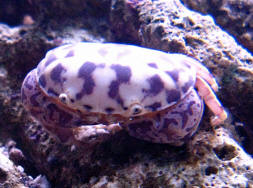 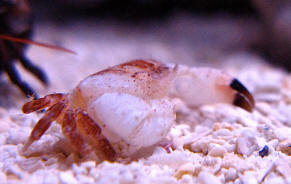
|
| Crab ID: Family Menippidae - Predator!
3/18/08 Hi, <Hi there!> I was wondering if you could
identify this hitchhiker for me. <I'll sure try!> At the
moment he is about 1cm so very small. <Good> He only appears
to come out when I feed the tank and is quite happy waiting for a
piece of flake to drift into his home (I cannot of course be sure
what he is doing overnight - probably terrorizing the tank!)
<Yep, these guys are nocturnal predators. During the day, they
seem to be mild mannered, snatching tidbits here and there, but at
night it's another story! The shape and red eyes are very
characteristic of crabs in the family Menippidae, Superfamily
Xanthoidea, otherwise known as 'Reef' or 'Stone'
crabs. I've seen similar (if not the same) crabs tentatively
identified as belonging to the highly toxic if ingested(!) genus
Eriphia (within the family Menippidae), but I can't confirm it.
Although these claims could well be correct, a slight
unseen/unrecognized physical characteristic could easily place the
crab's classification elsewhere. Aside from taxonomic issues,
these fairly common hitchhikers can unfortunately be very
aggressive towards other crabs/invertebrates, as well as small
fishes. At this size, it's not likely to do too much damage,
but unless you've got a large fish, FO system, I'd think
about moving it to a sump/elsewhere. Please see this link for an
example of several crabs in the family Menippidae:
http://www.geocities.com/ericdemuylder/menippid.htm. You can also
see several photos of very similar crabs at WWM. Use the Google
search engine with the terms 'Eriphia' and/or 'crab +
red eyes':
http://www.wetwebmedia.com/WWMAdminSubWebIndex/question_page.htm.>
Many thanks in advance <You're very welcome! Take care,
-Lynn> |
|
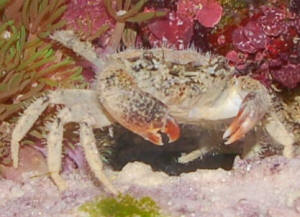
|
Crab identity... no use of WWM, rudeness
03/15/2008 Help! I bought a small crab with light blue color on the
top of the shell from my LFS. The store did not have another name for
it and did not have any culture information. I am also wondering what I
should feed the crab? Thanks Art <... Uhh... a terrestrial hermit?
Saltwater, fresh? Try using the indices, search tool on WWM. B>
|
Re: Worm ID Please, Now Crab ID - 3/3/08 Hi! <Hi Cath,
this is Lynn filling in for Bob this evening!> Thanks for the
answer. <On his behalf, you're very welcome!> I've
got now another ID for you. That was a little hairy crab who host
a Monti colony of another reefer of my area. <Okay> Look at
the joined pieces please and tell me if it is reef safe or not
and if you can ID this crab. <Hmm, it's hard to figure out
what's what in the photo, but it's likely a little
(coral) commensal Xanthid crab. As far as whether it's reef
safe - likely so, as long as it stays small and doesn't
irritate the coral too much. That is, if it's still alive.
Judging from the use of past tense and referral to
"pieces", I'm not so sure! If it is indeed still
alive, I'd keep an eye on things, offer it small meaty bits
(of marine origin) to deter predation and remove if
necessary.> Thank you! Regards. Cath <You're very
welcome! Take care, -Lynn>
Follow-up: RE: Worm ID Please, Now Crab ID - 3/3/08
<Hi Cath!> Thanks for the answer Lynn! <You're very
welcome!> Sorry for my bad English, <Your English is just
fine, so much so that I didn't realize it wasn't your
first language!> I usually speak French and I have little
difficulties with verb tenses!;-) <Well, I can sympathize as I
have the same problems now and then myself and it *is* my first
language!> Have a nice day!;-) <Merci bien et vous aussi!
-Lynn>
|
|
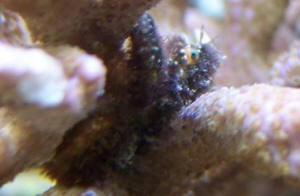
|
|
Two Crabs and a White Nudibranch? 2/24/08
Hello crew! <Hi there!> I've attached a few pics of
life (and former life) that I cannot identify. Whilst my intent
was not malicious, the two crabs did not survive the extraction.
<Unfortunate, but understandable - can be difficult to
remove!> As you can see, one is missing several appendages.
<Yep> I would've left them alone if my scarlet hermits
were not being ripped to pieces at night <Yikes!> and if I
hadn't read Calfo's opinion that crabs should be removed.
<They can indeed be very destructive.> So, right or wrong,
they are out and no longer alive. For the sake of learning and
not repeating a mistake if they were harmless, can these be
identified from the pictures I've provided? <They appear
to be in the superfamily Xanthoidea. The hairy crab looks like it
might be in the family Pilumnidae while the other could be in one
of several different families. No matter, this group of crabs can
be very destructive and I would have recommended their removal.
Please see these links (and those within at WWM) for more
information and photos for comparison:
http://www.wetwebmedia.com/marine/inverts/arthropoda/crabs/swcrabs.htm
http://www.nhm.org/guana/bvi-invt/bvi-surv/crab-g06.htm> Also,
there is a small interesting white (Nudibranch?) life form in my
tank. Pictures also attached. Ideas about ID? <Unfortunately
there are just too many possibilities. I can tell you, however,
that due to their specialized diets, these little guys do not
usually survive long term in most systems. Please see the
following links, especially the section at the bottom of the
first regarding issues associated with Nudibranchs:
http://www.wetwebmedia.com/nudispt3.htm
http://www.seaslugforum.net/ > Thanks so much. <You're
very welcome! Take care, -Lynn>
|
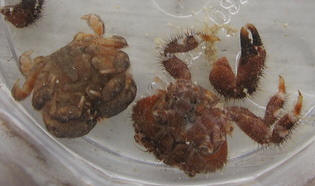 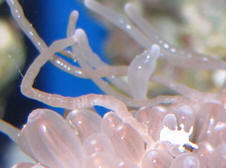
 |
|
|

